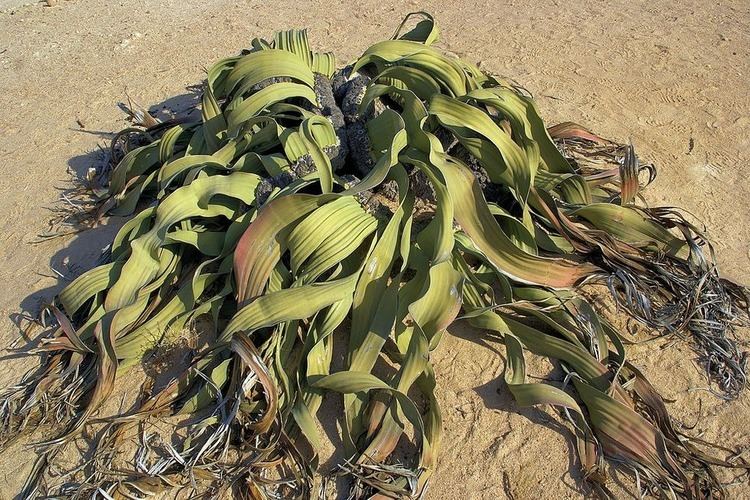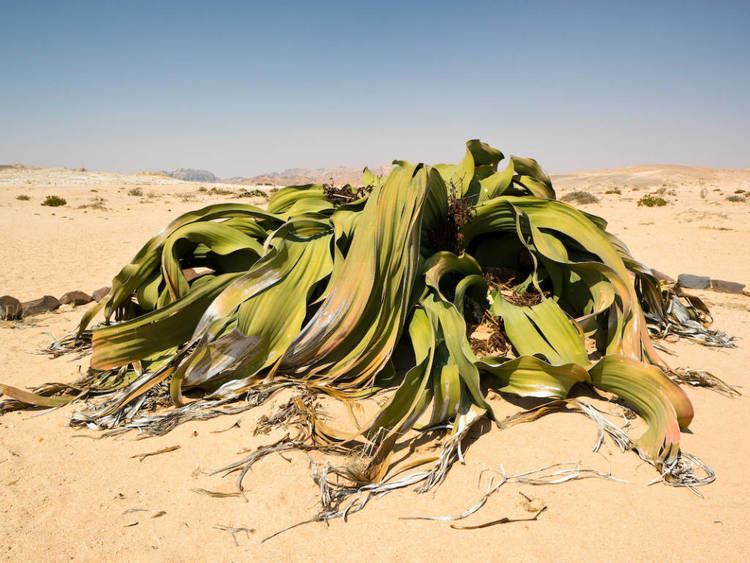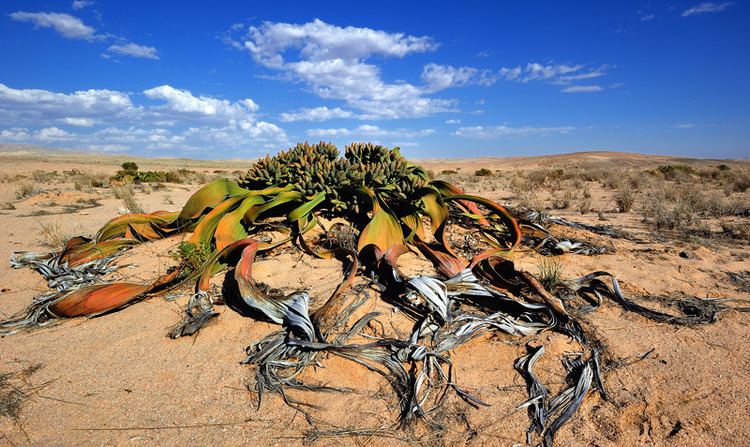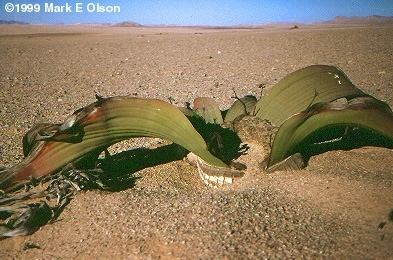Order Welwitschiales Genus WelwitschiaHook.f. Rank Species | Family Welwitschiaceae Scientific name Welwitschia mirabilis Higher classification Welwitschiaceae | |
 | ||
Did you know The first Welwitschia plant was discovered by Austrian botanist Friedrich Welwitsch (1806-1872)* in 1860 in the Namib desert in the southern part of Angola. Similar | ||
Welwitschia of the namib desert is truly a bizarre plant a living fossil
Welwitschia is a monotypic gymnosperm genus, comprising solely the distinctive Welwitschia mirabilis. The plant is commonly known simply as welwitschia in English, but the name tree tumbo is also used. It is called kharos or khurub in Nama, tweeblaarkanniedood in Afrikaans, nyanka in Damara, and onyanga in Herero. Welwitschia is the only living genus of the family Welwitschiaceae and order Welwitschiales, in the division Gnetophyta. Informal sources commonly refer to the plant as a "living fossil". Welwitschia mirabilis is endemic to the Namib desert within Namibia and Angola.
Contents
- Welwitschia of the namib desert is truly a bizarre plant a living fossil
- Taxonomy
- Biology
- Distribution and habitat
- Cultivation
- Conservation
- Heraldry
- References

Taxonomy

Welwitschia is named after the Austrian botanist and doctor Friedrich Welwitsch, who was the first European to describe the plant, in 1859 in present-day Angola. Welwitsch was so overwhelmed by the plant that he, "could do nothing but kneel down and gaze at it, half in fear lest a touch should prove it a figment of the imagination." Joseph Dalton Hooker of the Linnean Society of London, using Welwitsch's description and collected material along with material from the artist Thomas Baines who had independently recorded the plant in Namibia, described the species.
Welwitsch proposed calling the genus Tumboa after what he believed to be the local name, tumbo. Hooker asked Welwitsch for permission to name the genus Welwitschia instead. Welwitsch concurred and supplied some well-preserved material from which Hooker was able to make substantial progress in determining its botanical affinities. The taxonomy of Welwitschia subsequently changed intermittently with the development of new classification systems (see Flowering plants: History of classification), however, its current taxonomic status is essentially the same as Hooker's placement.

Most botanists have treated Welwitschia as a distinct monotypic genus in a monotypic family or even order. Most recent systems place Welwitschia mirabilis in its own family Welwitschiaceae in the gymnosperm order Gnetales.
Biology

After germination, the seedling produces two cotyledons which grow to 25–35 mm in length, and possess reticulate venation. Subsequently, two foliage leaves are produced at the edge of a woody bilobed crown. The permanent leaves are opposite (at right angles to the cotyledons), amphistomatic (producing stomata on both sides of the leaf), parallel-veined and ribbon-shaped. Shortly after the appearance of the foliage leaves, the apical meristem dies and meristematic activity is transferred to the periphery of the crown.
The two foliage leaves consequently grow continuously from a basal meristem reaching lengths up to 4 m. The tips of the leaves split and fray into several well-separated strap-shaped sections by the distortions of the woody portions surrounding the apical slit, and also by wind and adventitious external injuries. The largest specimens may be no more than 1.5 m tall above ground, but the circumference of the leaves at contact with the sand may exceed 8 m.
Welwitschia has an elongated, shallow root system consisting of, "a tapering taproot with one or more non-tapering extensions, some pronounced lateral roots, and a network of delicate spongy roots." and a woody, fibrous unbranched main stem. The roots extend to a depth roughly equal to the span of the living leaves from tip to tip. The main stem consists of an unbranched woody crown roughly shaped like an inverted cone. The only branching in the shoot system occurs in the reproductive branches, which bear strobili.
The species is dioecious, with separate male and female plants. Fertilization is carried out by insects. The insects responsible include flies and true bugs. The commonest of the true bugs attending Welwitschia is a member of the family Pyrrhocoridae: Odontopus sexpunctatus. The genus is also known as Probergrothius and the matter of which name is correct is still under discussion. Though much associated with Welwitschia mirabilis however, Odontopus sexpunctatus may not be a Welwitschia specialist as there are claims that it also occurs on other plants, such as Adansonia, though it is not clear how well-supported these claims might be. Infrequently, wasps and bees also play a role as pollinators of Welwitschia. At least some of the pollinators are attracted by "nectar" produced on both male and female strobili.
Welwitschia has been classified as a CAM plant (crassulacean acid metabolism) after reconciliation of some initially contradictory and confusing data. There are however some very puzzling aspects to the matter; for example, the employment of the CAM metabolism is very slight, which was part of the reason that it took so long to establish its presence at all; it is not understood why this should be.
The age of individual plants is difficult to assess, but many plants may be over 1000 years old. Some individuals may be more than 2000 years old. Because Welwitschia only produces a single pair of foliage leaves, the plant was thought by some to be neotenic, consisting essentially of a "giant seedling." However, research showed that its anatomy is not consistent with the giant seedling idea. Instead, the plant is more accurately thought of as achieving its unusual morphology as a result of having "lost its head" (apical meristem) at an early stage.
Distribution and habitat
Welwitschia mirabilis is endemic to the Kaokoveld Centre. The population is distributed southwards from the Bentiaba River in southern Angola, to the Kuiseb River in Namibia and up to 100 km inland of the coast. The area is extremely arid: the coast is recorded as having almost zero rainfall, while less than 100mm of rain falls annually below the escarpment in the wet season from February to April. Populations tend to occur in ephemeral water courses, indicating a dependence on ground water in addition to precipitation from fog.
Cultivation
Welwitschia mirabilis grows readily from seed, which may be purchased from specialty seed dealers. The seeds have been shown to display orthodox seed behavior, which in general means that they may be stored for long periods at suitably low humidity and temperature. Welwitschia seeds naturally develop suitably low water concentrations as they ripen.
Removal of the outer seed coverings enhances germination performance, which suggests that the seeds may display non-deep physiological dormancy. On planting the seed it is necessary to keep it moist, but not immersed in water, for the first couple of weeks of cultivation; it has been suggested that soaking the seeds in water before planting interferes with germination. Seeds collected from the wild often are heavily contaminated with spores of the fungus Aspergillus niger var. phoenicis, which causes them to rot shortly after they germinate.
The fungal inoculum infects the growing cones of W. mirabilis early during their development, and a sharp increase in infection occurs coincident with the appearance of the pollination drops, through which the fungal spores may gain access to the interior of the developing seed. Seeds in the wild may therefore be obliterated through fungal action even before they are fully developed. Seeds from botanical gardens, or other cultivated sources are much cleaner and less likely to rot. The fungicide tebuconazole may be useful in controlling limited A. niger seed infection.
Conservation
The population of Welwitschia mirabilis in the wild is reasonably satisfactory at present. Plants in Angola are better protected than those in Namibia, because of the relatively high concentration of land mines in Angola, which keep collectors away.
Although Welwitschia mirabilis is not at present immediately threatened, there being abundant populations over a large area, its status is far from secure; its recruitment and growth rates are low, and its range, though wide, covers only a single compact, ecologically limited and vulnerable area. The remarkable longevity of Welwitschia favours its survival of temporary periods adverse to reproduction, but it offers no protection against circumstances of direct threat, such as overgrazing and disease. Fungal infection of female cones severely reduces seed viability, reducing already inherently low recruitment. Other threats include injury from off-road vehicles, collection of wild plants and overgrazing by zebras, rhinos, and domestic animals.
Heraldry
The plant figures as a charge in the national coat of arms of Namibia.
